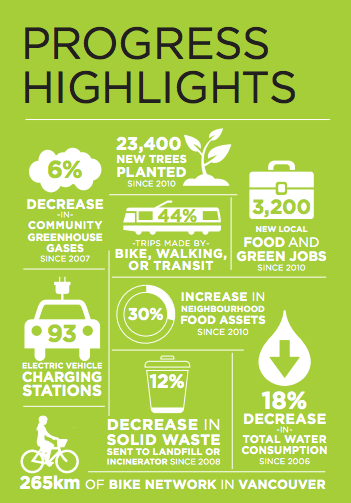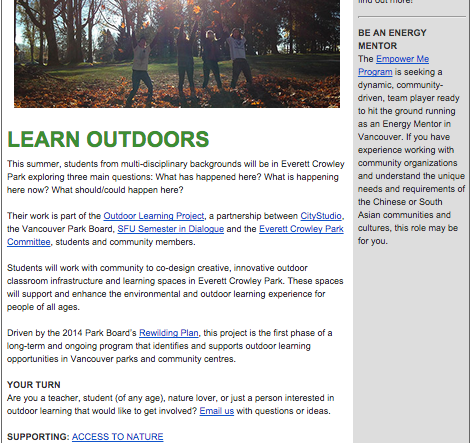You’ve spent several few hours of your time attending public meetings hosted by your municipality on the development of a new plan. You had to rearrange your child care and leave work early to attend. Wouldn’t you love to know how your comments on the proposed plan were used?

You may have heard about the City of Vancouver’s Greenest City 2020 Action Plan. Launched in 2010, the Action Plan planning process included a public engagement campaign that allowed residents to crowdsource ideas in an online forum. The Plan has ten goal areas, each with a specific 2020 target. The question asked in the forum was “How can we achieve reach our 2020 targets?” Guided by City staff, who moderated the forum, answered questions, and clarified levels of responsibility in implementation, participants suggested ways in which to meet the targets. Ideas were then reviewed and consolidated by staff, and participants were then able to vote on the ideas. As the status of an idea changed (under consideration, planned, started, completed, or declined), every person who voted on, commented on, or submitted the idea was notified by email. Since 2011, the City has published its progress on meeting the targets. The Greenest City 2020 Action Plan won the 2012 Sustainable communities Award from the Federation of Canadian Municipalities.
Five years after participating in the online forum, I still receive Greenest City Newsletters. They contain information about events in the city (e.g. Bike to Work Week, the BC Commuter Challenge, the proposed Kinder Morgan Trans Mountain Pipeline) and ways that residents can help meet the goals, such as using a rain barrel for collecting water to be used for lawns and plans. At the bottom of each section, they site the relevant Greenest City goal: Green Transportation, Climate Leadership, Clean Water. And each newsletter has dozens of links to City initiatives and programs.
Just last week I received an update that the City was already meeting its Greenest City 2020 goal for transportation mode share: 50% of all trips in the City are now made by walking, cycling, or public transit. This is a major increase from 40% in 2008. There are almost 100,000 bike trips per day in the City. Vancouver has done a lot to mainstream cycling, including designated cycling routes with signals at bike height and installing protected bike lanes on the Burrard Bridge, Hornby Street, and Union. Many of these changes have been introduced through pilot projects, which were carefully evaluated before becoming permanent.

In the past few years I have visited many universities in Canada, the US and Europe, and I often get to speak to local planners and scholars in urban planning. Every one of them has been amazed at the Greenest City newsletters. Not only was the planning process itself innovative, but the way in which the City has kept in touch with participants on how the plan is being implemented is very unusual. Many municipal planning websites are difficult to navigate–it can take some sleuthing to find the official plan, by-law, or meeting information that you need. All of the information for the Greenest City is in one place, so it’s easy to see the progress that’s been made, like the establishment of the Greenest City Fund to implement the ideas in the Plan, strategies on climate change, a new program on recycling food scraps, and improvements to walking and cycling routes. The newsletters make it easy to understand all of the policies, programs, and initiatives that directly relate to the plan, and they’re written in non-specialist language and designed with compelling graphics.
Obviously, Vancouver is a large city and its planning department has more resources than a small or mid-sized planning department might have. However, partnerships with universities and colleges might make it easier to reach out to residents and keep them up to date on planning initiatives, particularly on the social media front. City councillors might also be willing partners in communicating progress on implementation, since many of them send regular newsletters to their constituents. Most cities haven’t caught up to online participation methods, and don’t have well-organized websites or regular email updates for their residents. Practicing planners regularly check out plans, policies, and programs in other municipalities to inspire their own work, so providing clear online information and regular updates might inspire policy transfer and innovation in other places.
